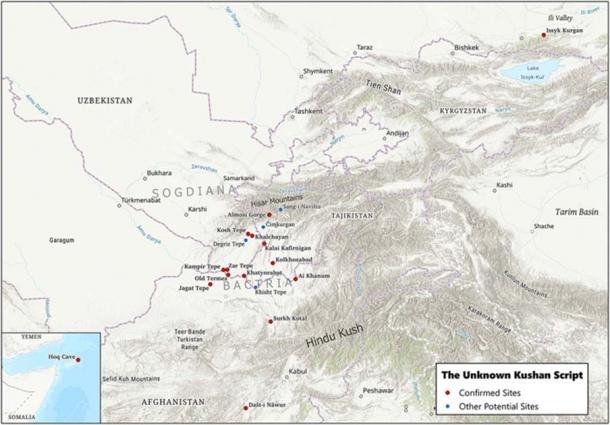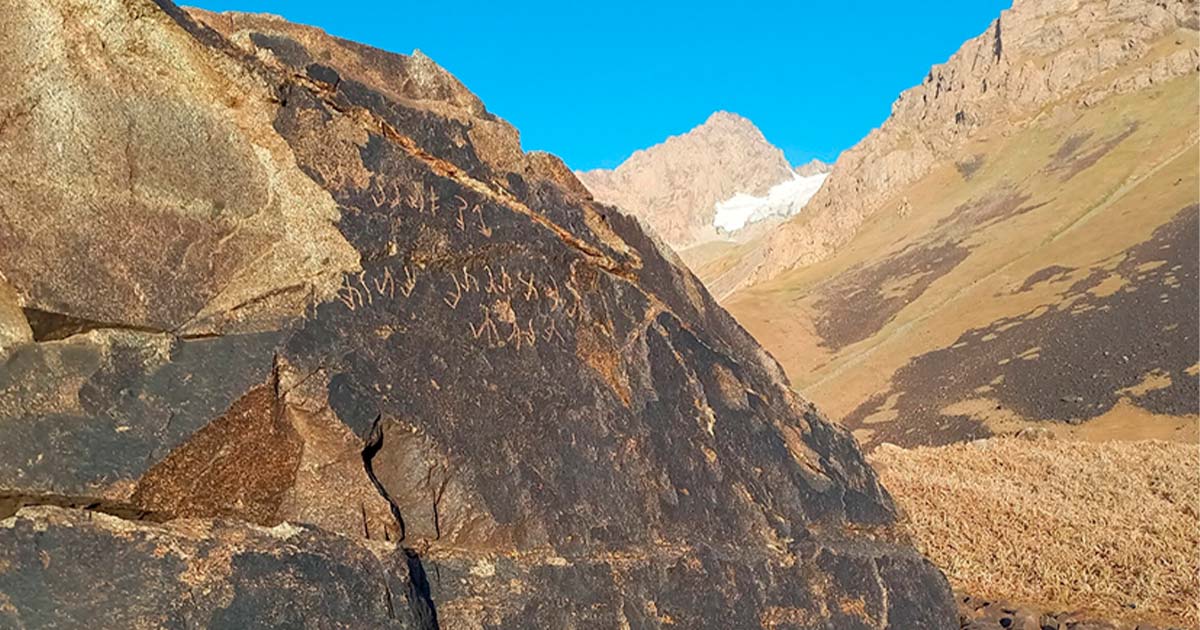2,000-Year-Old Unknown Kushan Language Is Finally Deciphered
Since the 1960s, archaeologists in Central Asia have found rocks carved with a mysterious unknown language. Now, a team from the University of Cologne has deciphered the unknown script, revealing it emerged among traders on the Silk Road.
Founded by the Kushan tribe, the Kushan Empire flourished from the 1st to 3rd centuries AD. Spanning Central Asia and parts of South Asia, Kushan religion was influenced by Buddhism, Zoroastrianism and Hinduism, which all penetrated Kushan culture via trade along the Silk Road.
Cologne University was founded in 1388 AD by Pope Urban VI, focusing on theology, philosophy and linguistics. Now, keeping in alignment with the institute's original traditions, a research team from the University’s Department of Linguistics has decoded 60% of the ancient Kushan writing system known as the “Unknown Kushan Script.”

Map of the find sites of the various inscriptions which have now been identified by linguists as an ancient Kushan language. (Bonmann, S. et. al. / CC BY-NC-ND 4.0)
Interpreting Clay Pots and Cave Walls / Unknown Kushan Script
According to UNESCO, both Sanskrit and Prakrit languages pre-date the Kushan Empire, and Bactrian and Sogdian were spoken by the merchants who engaged in Silk Road trading across Central Asia. However, while much is known about these language systems, until now there remained much to be discovered about the languages of the Kushan Empire.
The so-called “unknown Kushan script” was first identified by archaeologists in the 1960s, but now, Professor’s Svenja Bonmann, Jakob Halfmann and Natalie Korobzow have examined sections of the unknown script found on cave walls, clay pots and bowls in several Central Asian countries.
- 10 of the World’s Oldest Languages Still Used Today
- Irish Academic Adds Ancient Babylonian Authenticity to Eternals Movie
The team initially announced their “partial” decipherment of the language on 1 March 2023, during an online conference organized by the Academy of Sciences of the Republic of Tajikistan. Now, a new study about their work has been published in the journal Transactions of the Philological Society under the title “A Partial Decipherment of the Unknown Kushan Script.”
According to the new paper, the team have successfully deciphered about 60% of the characters of the unknown Kushan language script that was widely used in Central Asia between about 200 BC and 700 AD.

Stone 1 which was found at Almosi Gorge, in northwestern Tajikistan, included an inscription written in the unknown Kushan language script. (Bobomullo Bobomulloev / CC BY-NC-ND 4.0)
Understanding Phonetic Properties of Kushan Language Turned the Key
Most of the known ancient Kushan language scripts have been found in modern-day Tajikistan, Afghanistan and Uzbekistan. However, in 2021 a short script was found carved into a rock face in the Almosi Gorge, in northwestern Tajikistan. Not only did this rock face feature a rare example of unknown Kushan script, but it also held a small example of the Bactrian language.
The University of Cologne team leaned on tried and tested means to decipher the ancient language, including, for example, the methodology used to decipher the Egyptian hieroglyphs using the Rosetta Stone.
An article about the new study on PHYS explains that the so-called breakthrough came in the decipherment of the “royal name Vema Takhtu,” which was written in both Bactrian parallel texts. Then, the term “King of Kings” was identified in the corresponding sections.
The Kushan language study said these revelations “proved to be a good indicator of the underlying language.” Using Bactrian parallel text, the team then analyzed character sequences, revealing the individual characters’ phonetic properties.
Nailing the Unknown Iranian Kushan Language
The new study concludes that the unknown Kushan language script is “a completely unknown Middle Iranian language, which is neither identical to Bactrian nor to the language known as Khotanese Saka, which was once spoken in western China.” Furthermore, it is thought that the newly decoded language “probably occupies a middle position in the development between these languages,” according to the study.
- New AI Algorithm is Cracking Undeciphered Languages
- Bactria - The Bountiful, Sought-after Region of Ancient History
Who then used this almost lost and forgotten language? The researchers wrote that it might have been the language of the settled population of northern Bactria, which is now part of Tajikistan. But they also speculated that it might have been used by the Yuèzhī nomadic groups in Inner Asia, who had originated in northwestern China.

The term “king of kinds” was identified in engravings written in the Kushan language script in this sample from Almosi Goege (left) and Dašt-i Nāwur III. (Bonmann, S. et. al. / CC BY-NC-ND 4.0)
Spreading Culture and Language Along the Silk Road
Lead author Professor Svenja Bonmann said her teams decipherment of this script will “help enhance our understanding of the language and cultural history of Central Asia and the Kushan Empire, similar to the deciphering of the Egyptian hieroglyphs or Mayan glyphs for our understanding of ancient Egypt or Mayan civilization."
What the new study essentially demonstrates is that this newly identified Iranian language, that is provisionally named “Eteo-Tocharian,” was one of the official languages used by the Kushan Empire. It also hypothesized that this ancient system of communication was primarily used by traders along the Silk Road at the same time as the Bactrian, Gandhari/Middle Indo-Aryan and Sanskrit languages.
Top image: Location of bilingual inscription, which helped linguists crack the ancient Kushan language, in Tajikistan. Source: Bobomullo Bobomulloev / CC BY-NC-ND 4.0
By Ashley Cowie

















